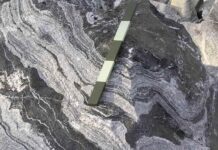
Research into micro-meteorites, meteorites smaller than 2 millimeters, found in Western Australia have shed new light on the make-up of the ancient Earth’s atmosphere.
The Pilbara region in the north of Western Australia has the oldest rocks in Australia, and some of the oldest in the world. Most have barely changed since they were deposited as sediments billions of years ago which allows researchers to unlock secrets of the atmosphere.
“The micrometeorites we extracted travelled through the atmosphere about 2.7 billion years ago. That period is called the Archean Era,” says Monash University’s Dr Andrew Tomkins.
“Imagine an impact between two asteroids in space. Most meteorites have metal particles in them, so when two asteroids collide, lots of fragments come off, and you end up with cosmic dust.
When that dust enters the Earth’s atmosphere, researchers estimate it is moving at more than 12 kilometers a second. Because it’s moving so fast, the fragments can also reach temperatures of more than 1500 degrees.
“As the micrometeorite is traveling at great speed and high temperature, it comes into contact with the Earth’s atmosphere which causes it to slow down and cool off.” Prof Tomkins says.
“When these micrometeorites land on Earth, that information is stored. If that micrometeorite lands in a lake, it can get buried in sediments and becomes preserved in rock”.
Dr Tomkins says his research investigated the interactions between the micrometeorites and the upper atmosphere to reveal how the ancient atmosphere differed from today.
“We targeted a type of sedimentary rock, called limestone, because it is easily dissolved to reveal the micrometeorites,” he says.
“Those particular micrometeorites had been bits of metal floating around in space.”
As the micrometeorites reacted with the oxygen and iron in the atmosphere, it turned from iron mostly, to iron-oxide.
“That told us that there had to be a certain level of oxygen available to do that,” Prof Tompkin says.
Imperial College researcher Dr Matthew Genge performed calculations that showed oxygen concentrations in the upper atmosphere would need to be close to modern day levels to explain the observations.
“What we had done was found a way to show that there was more oxygen than previously expected, and less carbon monoxide,” Dr Tomkins says.
“The findings show the upper atmosphere was oxygen-rich, whilst still allowing the possibility that the lower atmosphere was oxygen-poor. It is basically the first time anybody has been able to figure out a way to look at the chemistry of the upper atmosphere billions of years ago.”
Note: The above post is reprinted from materials provided by Science Network WA.









